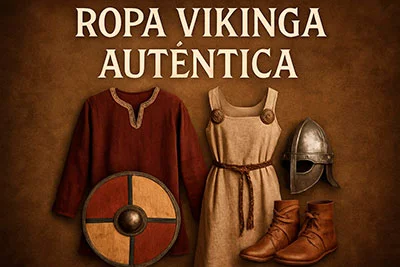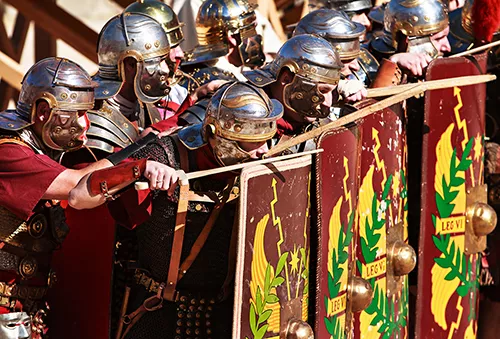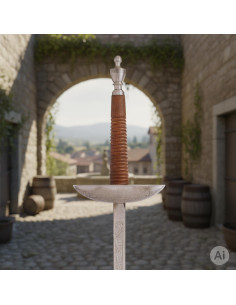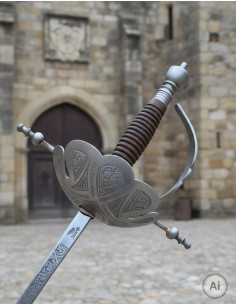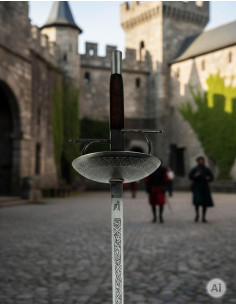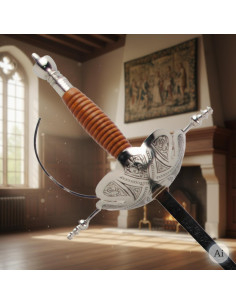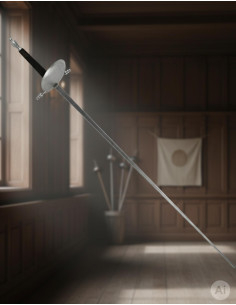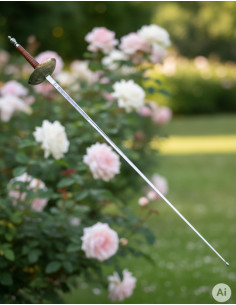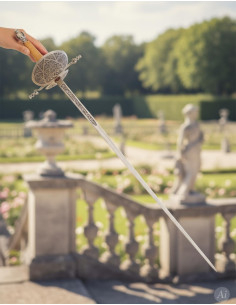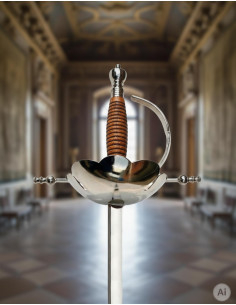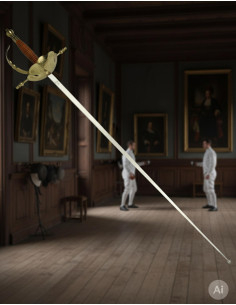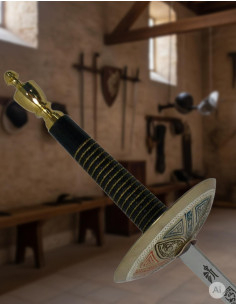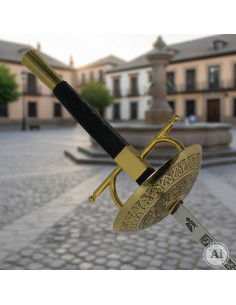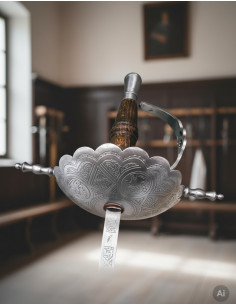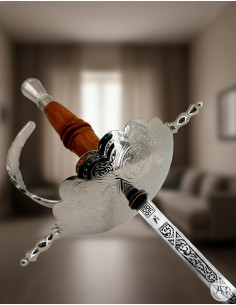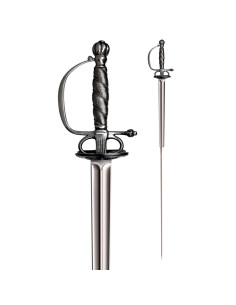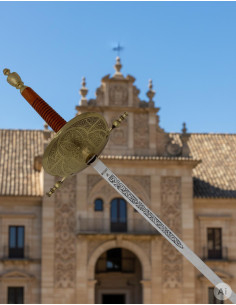Florets
Variety and styles among Foils: how to recognize each model
The Foils category brings together a wide range of models that combine aesthetics and history with different uses. You will find decorative pieces such as the French decorative Foil, nickel-plated, or the decorative shell Foil, nickel-plated, as well as examples with a rustic look like the rustic French Foil or the rustic Colonial Foil. Brass-plated and gold-plated finishes are also included —for example, the Castañeta Foil, brass-plated, or the gold-plated French Foil— which provide visual presence both in display cases and in recreational practice. Each type offers a different feel in the guard and grip due to its weight, handle and hand guard.
The selection also includes functional and historically oriented pieces: the functional French Colichemarde smallsword or the European sword or smallsword, 18th century, intended for those seeking authenticity in technical training or historical displays. Other models, such as the decorative Castañeta Foil, smooth nickel, balance ornamentation and ergonomics, making them ideal for collectors who value design fidelity. This variety makes it easier to choose a foil according to its intended use: sport fencing, technical training, stage props or decorative collection.
Materials and finishes: importance for use and aesthetics
Materials and finishes determine both the durability and the appearance and feel of the foil. In the Foils category we find nickel-plated, brass-plated, gold-plated and aged finishes; each affects maintenance and resistance to corrosion. A nickel-plated foil, for example, usually offers a shinier surface more resistant to wear, while a brass-plated or aged finish provides a classic patina that enhances its historical character. Rustic models are designed for those seeking a more authentic aesthetic, with textures and details that evoke antique replicas.
Besides the metal of the guard and the shell, the quality of the blade steel (or the scabbard where applicable) and the construction of the grip affect balance and safety during use. For foils intended for sport fencing and training, it is common to choose materials that withstand intensive use and allow simple maintenance, whereas purely decorative foils prioritize aesthetic finish. Knowing the properties of each finish will help you select the right foil for your needs: display, practice or training.
Foils for sport fencing and training: functionality and safety
If your goal is continuous practice, foils designed for sport fencing and training must meet standards of ergonomics, balance and safety. An actively used foil has a flexible blade and a safety tip adapted for regulated contact, as well as a grip that facilitates handling during quick changes of hand. In our selection there are functional models such as the functional French Colichemarde smallsword, designed for technical exercises, and other pieces that, although decorative, offer sufficient solidity for light practice. It is key to distinguish between ornamental replicas and foils suitable for training to avoid unnecessary risks.
Choosing a foil for training involves considering weight, usable length and feel in the hand; the presence of a castañeta or a robust shell guard can influence protection and control of the weapon. Additionally, regular maintenance and the use of approved protective equipment are essential if the foil is used in sport fencing sessions. Evaluating each model based on its technical specifications and user experience will allow you to get the most out of the foil, both in technique and safety.
How to choose the right Foil according to your level and purpose
Selecting the correct foil depends on your level —beginner, intermediate or advanced— and the purpose: training, competition or exhibition. For frequent technical training it is advisable to opt for balanced and durable pieces; models with nickel-plated or brass-plated finishes usually withstand continuous use better. If you are looking for a foil for exhibition or decoration, gold-plated or rustic designs, such as the gold shell Foil or the rustic Spanish Foil, offer greater visual impact. For those who combine practice and aesthetics, there are mixed options, like the decorative Castañeta Foil, smooth nickel, which harmonize appearance and functionality.
When deciding, it is recommended to evaluate the type of grip and the ergonomics of the handle, as well as the total weight and the balance point. A foil that is too heavy can hinder technique in the early stages, while one that is too light can limit control in advanced actions. Also consider compatibility with protective gear and the possibility of replacing parts if the model allows it. Trying the grip type and checking the technical specifications of each model will help you find the ideal foil for your sport fencing and training sessions.
Care, maintenance and preservation of Foils
Regular maintenance extends the life of any piece in the Foils category. It is advisable to clean metal surfaces with a dry cloth after each use and apply metal-specific products when the finish requires it, especially on nickel-plated or brass-plated pieces. Avoid humidity and store foils in covers or supports that minimize contact between pieces to prevent scratches and corrosion. Components such as the castañeta or the shell guard should be checked periodically to ensure there are no loosenesses that affect balance or safety during use.
For foils with patina or aged finishes, use gentle care that respects the aesthetic patina; in contrast, gold finishes require protection from aggressive chemicals. If used in training, frequently inspect the blade and tip to detect material fatigue. In the case of historical or collectible pieces, such as European smallswords from the 18th century, professional conservation and controlled storage in terms of humidity and temperature guarantee their preservation. With good cleaning habits and periodic checks, your foils will maintain their performance and appearance for years.
What is the difference between a decorative foil and one for training?
A decorative foil prioritizes aesthetic finish: ornamental details, patinas and materials that seek visual fidelity. It may not meet requirements of flexibility, safety or balance for continued use. A training foil, on the other hand, is designed with ergonomics, durability and a safety tip, suitable for repeated exercises and regulated contact. Check the product description to confirm its recommended use.
What advantages do nickel-plated, brass-plated or gold finishes offer in Foils?Finishes modify wear resistance and appearance. Nickel-plating offers shine and greater protection against corrosion; brass-plating provides a warm tone and moderate resistance; gold-plating enhances aesthetics but may require specific care to preserve the shine. The choice depends on whether you prioritize intensive use, decorative display or historical value.
Can the Functional French Colichemarde smallsword be used in technical training?Yes, the Functional French Colichemarde smallsword is intended for practices that require precision and technical handling, with a design that favors control. Still, always verify the piece’s characteristics (flexibility, safety tip and balance) to ensure it meets your sport fencing and training needs before incorporating it into demanding sessions.
How do rustic models influence practice and aesthetics?Rustic models usually offer a more authentic, textured aesthetic, ideal for historical reenactments or collections. In practice, they may have slight variations in grip or weight compared to polished models; however, many rustic foils are perfectly suitable for recreational training. If you seek competitive performance, confirm the technical specifications of the specific model.
Can parts like the castañeta or the shell be replaced on Foils?In many models it is possible to repair or replace components such as the castañeta or the shell guard, especially in foils designed with removable fittings. The availability of spare parts varies depending on the design and the age of the piece. Reviewing the technical specifications and the manufacturer’s recommendations will help you determine the ease of maintenance and repair for the foil you are interested in.
What signs indicate that a foil needs maintenance or replacement?Common signs include looseness in the guard or shell, deformations in the blade, visible corrosion or loss of balance. Also pay attention to cracks in the handle or excessive wear on the tip. If you notice changes in handling response or any structural damage, have a professional inspection and avoid use until the issue is resolved to maintain safety during training.
Are historical Foils such as the European sword or smallsword, 18th century, functional?Many historical replicas are manufactured with aesthetic fidelity to the original and can be suitable for exhibition or controlled recreational practice. However, their functionality for sport fencing depends on construction and materials. If you seek continuous use in technical training, choose versions specifically designed to be functional for that purpose or consult the product specifications.
Explore our carefully curated selection of Foils for sport fencing and training: from functional models to historical decorative pieces. Find the ideal foil to practice, train or exhibit and improve your technique with quality and style.

